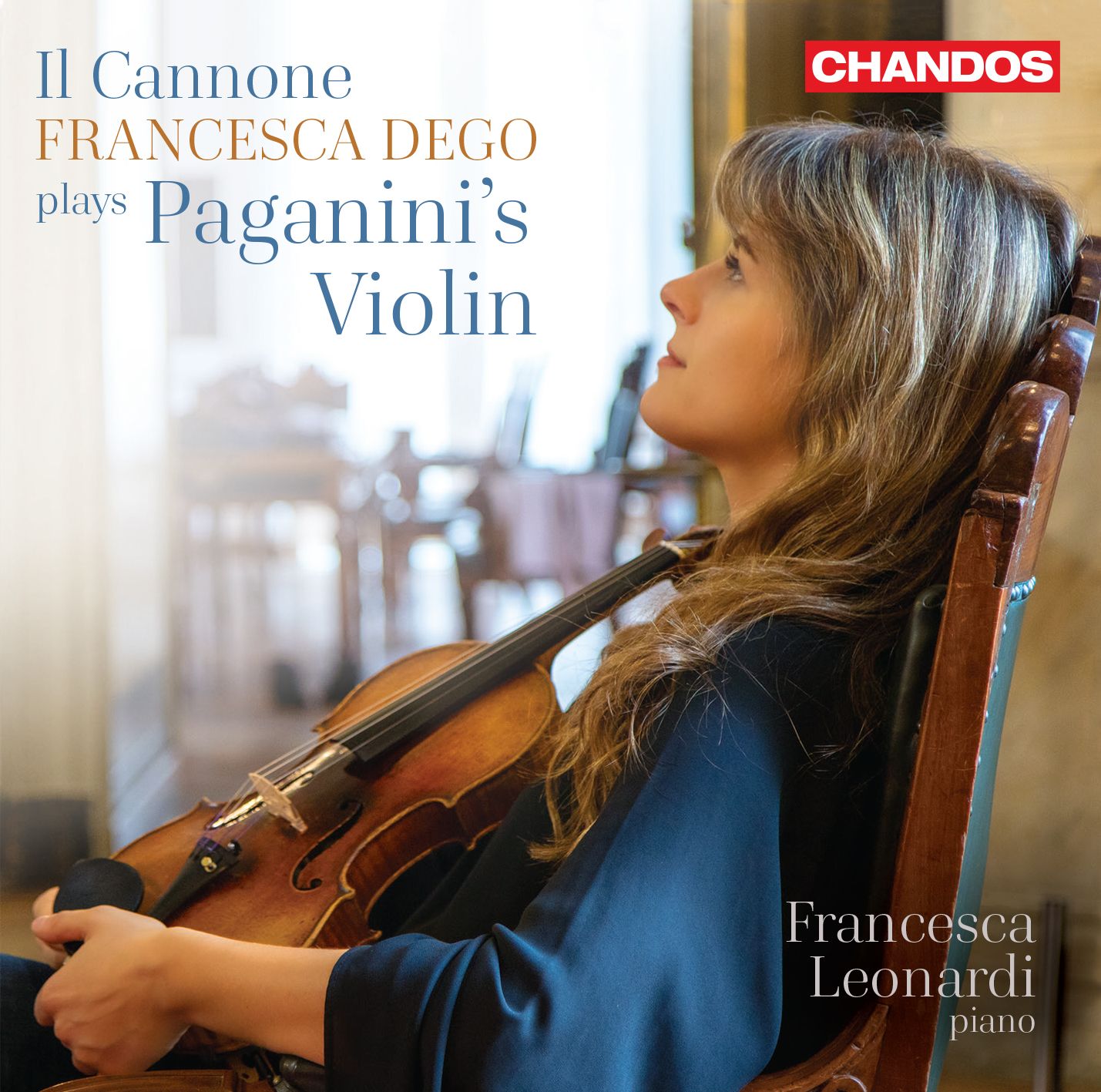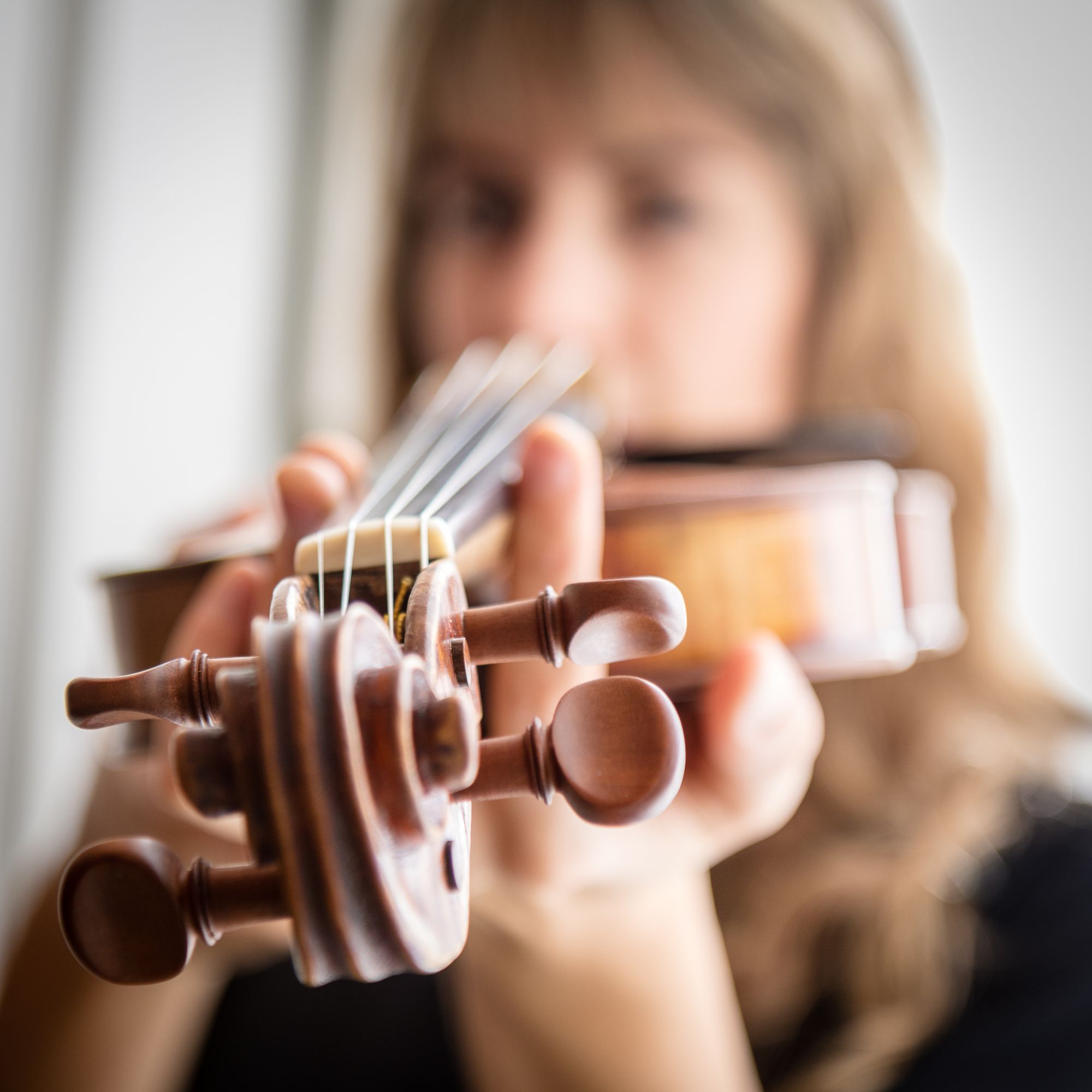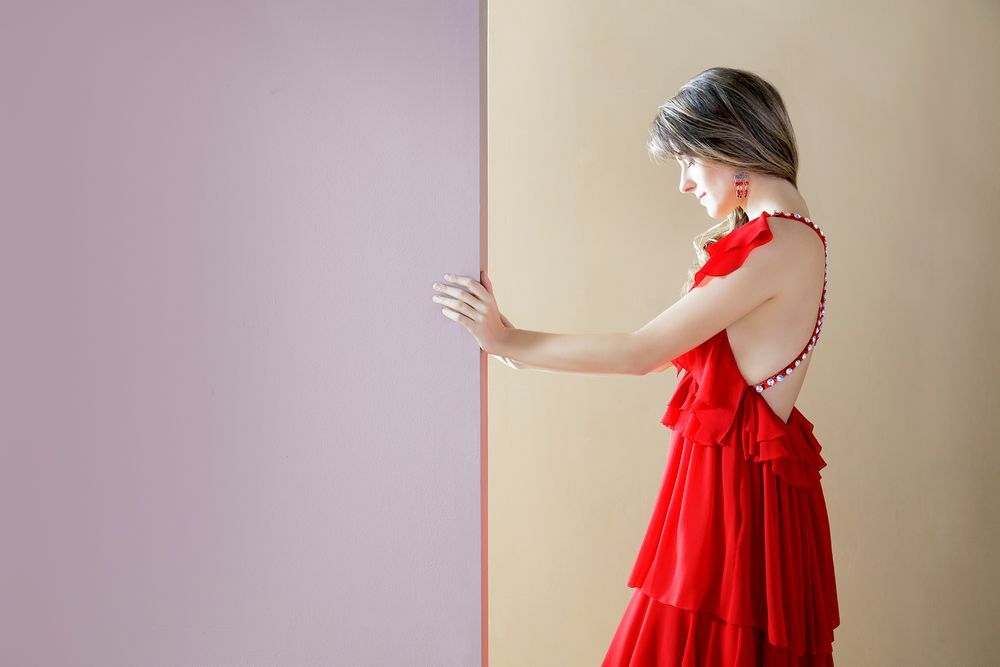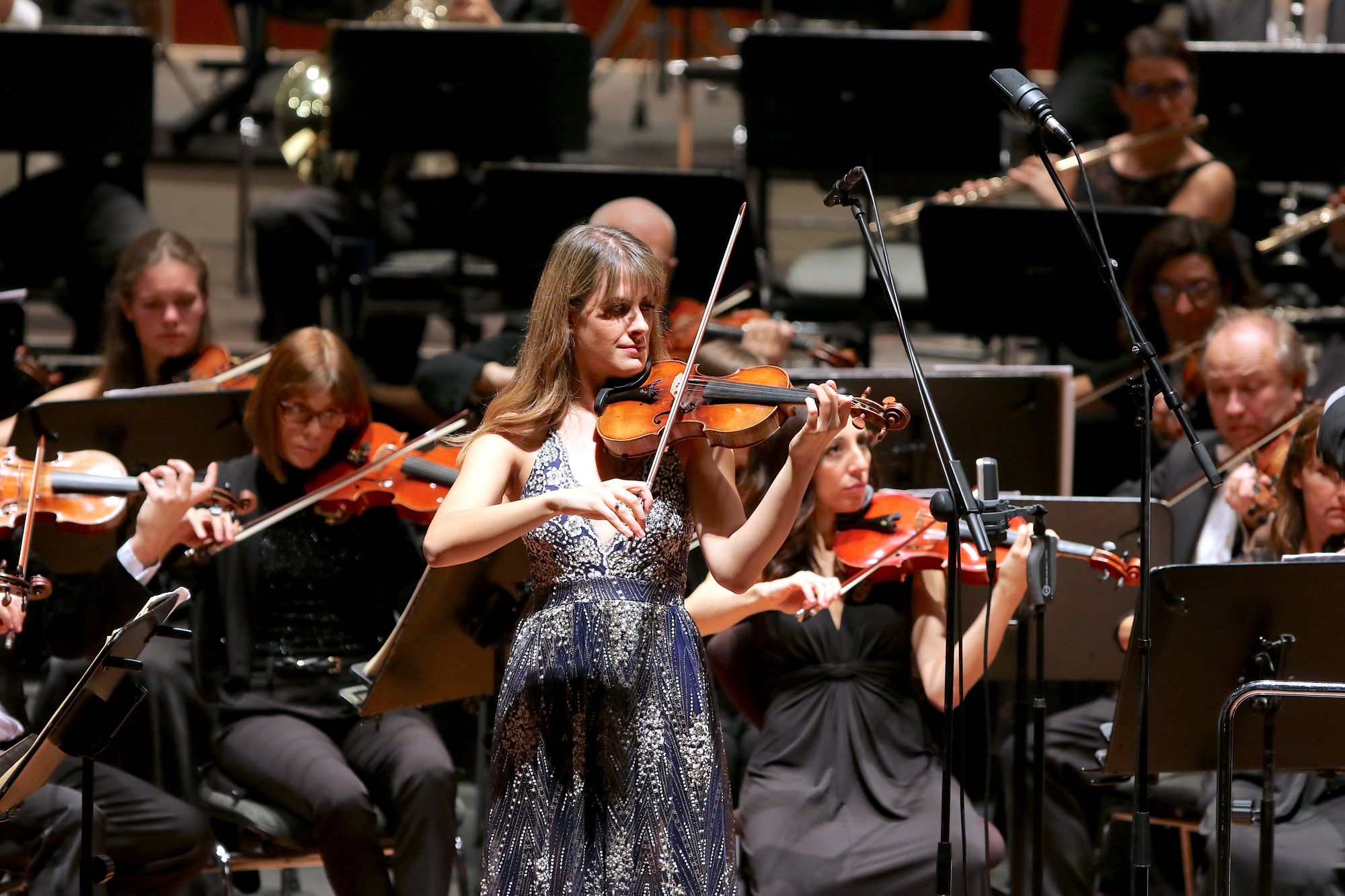Living the Dream: Francesca Dego records on Paganini's "Il Cannone"
The opportunity to record on Paganini's own violin, the legendary "Il Cannone" (a Guarneri del Gesû, 1743) hardly comes along every day ...

The opportunity to record on Paganini's own violin, the legendary "Il Cannone" (a Guarneri del Gesû, 1743) hardly comes along every day. It was a pleasure to speak with violinist Francesca Dego who, for her debut release on Chandos, has recorded, on this very priceless instrument, music "around" Paganini rather than by Paganini: works and arrangements by Kreisler, Corigliano, Boccadoro, Rossini, Schnittke and Szymanowski.
Before we get down to the interview proper, the minutiae about the instrument and the works that are played, perhaps let's get a flavour of the disc. Here's the Paganini/Kreisler La Clochette, an arrangement of the Rondo finale from Paganini's Second Violin Concerto in B minor, Op. 7. Here, as elsewhere on the disc, Dego is joined by her longtime duo partner Francesca Lombardi:
As Dego explains,
Paganini was the only owner of the instrument - he played it for almost 40 years and left it to the city [of Genoa] so since then it's only been played by passing soloists, usually for ceremonies or very short concerts. So in its life the violin has only really played Paganini's music. I first of all wanted to underline what a great instrument it is - how it can bring out the best in any repertoire. The most recent piece in the album was written in 2019, right before the recording; I wanted to explore all the possible nuances this violin has in this incredible sound while remembering its famous owner. So all the pieces have Paganini behind every note, but none are pure Paganini. I thought it was quite toucing to imagine how happy Szymanowski or Schnittke would have been to know that the pieces they dedicated to Paganini were going to be played with his own violin. Still today, Paganini inspires so much music to be composed. This is the aspect I wanted to tell people about and choose contrasting pieces from different eras.
It was love at first sight for Dego: some violinists who encounter the instrument do so in a sort of frenzy of terror when they have won the Premio competition and receive it for a few minutes to play a Caprice in front of an audience. The Chandos experience is all calmer, but the violin itself has some individual characteristics: it has its original neck, which is a bit shorter than the norm, so the fingerboard makes up for it by getting longer towards the end, so one has to get used to different positions going higher up. "That's particularly tough when you have jumps," Dego says, but experience on lots of old Strads has given her coping strategies. They also used new strings, added on the day they started recording, and those need adjustment, too.
Any great violin puts in a lot of its own personality when you encounter it, so if you have the patience and a tiny bit of time to shut everything out and adapt to it, it can give you so much. And this violin makes a few things easier! It has such a prodigious production of overtones that it speaks very easily. It is strangely healthy for a violin that hasn't been played so much and is so old, but it is considered quite young in its actual playing career because it pretty much only played with Paganini, then only sporadically after. So its in pristine playing condition, and you can hear that. You do have to adapt. For me, it was love at first sight. There's a magical thing that happens when a violinist finds an instrument that embodies your own ideal of sound, and that's what happened to me. I enjoyed every minute.

"Il Cannone" is a slightly larger model of a Guarneri, but as Dego says when you have an instrument that's so wonderful, it gives back what you put in. "I felt the sense of responsibility very keenly".
The strong overtones make it easier to play the harmonics and makes them more effective - and it was Paganini who introduced double harmonics. Nobody had done that before him. "The fact he did that and that he had an instrument that made it worth it - they sound really good, They sort of naturally sound. This is the instrument Schubert and Goethe heard."
"Il Cannone" is Paganini's own nickname for the instrument and refers to its large sound; in letters, Paganini would refer to it ias "Il mio cannone violino" (my violin cannon). "It projects wonderfully it has this richness of sound. We used extra microphones as we wanted to catch what it sounded like under my ear". Chandos has always had a reputation for excellent recorded sound; for security reasons they had a one-man recording/engineering team, Patrick Allen, who even took the photos. "It was an adventure," Dego says. (Previously a DG artist, Dego now enjoys an exclusive contract with Chandos.)
There's a story that Paganini lost an Amati violin via gambling and was gifted a neglected Guarneri that he played for the rest of this life, "Actually, nobody knows exactly how he came into contact with the violin. He may well have lost in gambling; but he knew what he was looking at. He was constantly looking at violins and making money from them. At that time del Gesù who became so famous, thanks to this very violin, wasn't that well regarded yet. He was this weird obscure violin maker who'd been in prison ... it's very interesting that Paganini chose this violin when the glamour pointed in another direction. He left it to the city. For many many years they put it in a glass bell, like a relic, together with the sword of one of Italy's revolutionaries. A very 19th century idea of what a city should be!. There are some early photos where you can see old rosin - it was a relic in the sense that nobody touched it for years, and that didn't help the restorers."
Dego decribes the sound itself in terms of lava and hot chocolate, velvety and wise. So what violin does you go back to that is your "usual" violin? "I have a gorgeous Francesco Ruggieri from 1697, so older than "Il Cannone," a violin I fell in love with. I'm very happy to go back to it; for some years I played another del Gesù, the "ex-Ricci" from 1734, an older brother of "Il Cannone". I keep wondering if part of "Il Cannone" is the mystique of the instrument, but I would definitely have been happy to play it for the rest of my life. When they do scientific researches, they need someone to play it, so I offered to do that ..."

Let's get down to the music. Bringing back Kreisler to contemporary consciousness is a great thing; some readers might have come across the Naxos Historical reissues of his recordings, including his own pieces and his arrangements. Bringing that back to our attention now is important and was very much part of Dego's thought processes.
... and to some extent Paganini, though legendary, is sometimes misunderstood; as is Kreisler. Their figures were so important for history and for their activity at the time so some people underestimate them in the big picture, which for Paganini doesn't make any sense. He was one of the real revolutionaries of the Romantic era. What he did to people like Chopin and Liszt, who basically reinvented themselves after hearing him, that would be enough. But he's been relegated often, as has Kreisler, to lighter music that is more for show and circus than anything else, so I wanted to underline what he meant to these compsoers throughout history. And Kreisler is really important because he dedicated himself to rewriting so much of Paganini. To some extent that's naïve because Paganini doesn't need to be rewritten. But Kreisler was bringing it to the concert stage of his own time, for what he knew he needed and what the audience needed. So some of the pieces are shorter, the piano accompaniment is richer, or, for La Campanella, the original is for violin and orchestra, so I'd rather play the Kreisler than just the piano reduction. Kreisler was someone very different who read into Paganini into a way that today would be unacceptable. We have people like Salvatore Accardo going back to the whole Italian heritage. It's the beauty of the importance of this figure, and everybody came to terms with Paganini in his own way.
In the programme, it's only Rossini who knew Paganini personally, and he describes him in Un mot à Paganini that is really touching and connected to the Italian bel canto style "rather than the diabolical part that remaned attached to Paganini's image":
"On the other hand, someone who didn't know him and who was attracted by that [diabolical/devilish] part was Schnittke who writes a piece that is compoletely crazy inhis own language but totally reflects that idea of Paganini," says Dego. "There's been so much said about Paganini and his legend that it was important and interesting to see how legends survice and how everyone reinvented him in their own way. And that's fine, it comes with admiration. I think Paganini would have loved it."
(I think of pieces in the history of piano music that fit this aesthetic - perhaps the Chopin/Godowsky Etudes are in just this spirit.)
When it comes to John Corigliano and his music for the 1998 film The Red Violin (another violin, but it still mixes truth and legend and what imagination has done to how we seen Cremonese violin makers of the past). In his The Red Violin Caprices (1997) there are notable quotations from those Caprices. Corigliano is very, very connected to the violin - his father, John Corigliano Snr, was concertmaster with the New York Philharmonic for 23 years.
The violin has always meant a lot to Corigliano. What Paganini did - he was fed with Italian opera. before going on tour he hadn't even heard anything by Mozart or Beethoven. all he heard was Italian opera and that's what his inspiration was, what his soundworld was. And that's what he wanted to bring to the violin. I love that emphasis on theatre to his music, and Corigliano does something that's really great, he brings his own theatre background (Hollywood) in to the violin language. It's extremely tehatrical, using effects Paganini used plus direct quotes (the Octave Variation) but in a completely different atmosphere and it speaks to us as opera would have spoken to Paganini's audience"
The Corigliano uses the full registeral spectrum of the violin, all equally compellingly. How does that translate onto "Il Cannone," I wonder?
It's exactly what you'd expect from a top del Gesù, that really smooth going from one string to the next, but it has all the personality, especially in the G string - and we also know how Paganini was fixated by the G-string. He wrote whole compositions to be played only on the G-string. They say he sometimes used to cut the other strings a bit so they'd break so he'd have to play only on the G-string (I don't know if that's possible without it all collapsing!). The G-string is extraordinary, very loud, and easily responds except for a high C which has a pronounced wolf tone. I was very struck by the ringing quality of the high register, that's just as amazing. Often we ask how good is the G-string, but this is peircing in the high register, a singing quality, exactly what you'd think of a violin imitating opera. It has amazing possibilities in all register. I wanted a programme that really takes it to ist limits in all its registers.
What lingers in my mind is both that vocal quality of the instrument, and of Dega's playing, in pieces like Carlo Boccadoro's Come d'autunno, dedicated to her, or the Paganini Cantabile in D, Op. 17, with its newly realised piano accompaniment by Boccadoro:
Its an element that's very important in Paganini, and I wanted to underline that. If you listen to his concertos, the second movements sound like Bellini or something, he had an incredible ease with melodic material - catchy tunes. He was then accused of not orchestrating them very seriously, but the invention is miraculous. Rossini said that 'thank goodness he didnt write opera or we'd all be without a job'. That shows what they thought of him incredible musical material. I asked for this new arrangement of the "Cantabile" because it's such a little gem but it didn't fit without an arrangement. I'm very happy we did - there's a very rich piano accompaniment [to the Cantabile], envisioned as an ideal meeting between these two contemporarires, Paganini and Chopin. I thought that was a nice way of including this piece and giving it a little twist.
And of course Chopin himself was influenced by Bellini (try the Nocturnes!) , so it comes full circle.
There is such balance in Dego's programme, too. She does Rossini a great service with that late work, but it is the complex, refreshing, challenging but approachable Schnittke who takes the material and stretches it.
Which brings us to the Szymanowski.
In a way its funny that in Kreisler and Szymanowski, I was able to milk it. I normally don't play Paganini like this - I went into the feeling of those people of the composers who revisited him and how they would have thought of him. We know how Kreisler played and it was very different. So I got to play Paganini thinking of Kreisler or Szymanowski, so that second movement of the Szymanowski is a way to get out all the big vibrato and all the things I would avoid in that Caprice in the "pure" version, so I think that was intentional. It's not a stylistically wrong approach to Paganini, its a Szymanowski approach to Paganini, which is what he wrote. It's interesting, the violin part is similar to the original and he uses articulation and phrasing that he would have found in editions from his time but aren't very realistic and have since been put aside for the Urtext. So it's interesting how they would base their own version on what was circulating, which was this encrustation of violin tradition which changed everything of Paganini. And I wanted to bring that out and its part of the history of Paganini playing. It's just the latter part of the 20th century that the academic approach reached his music.
I think of Schenker's edition of Beethoven Piano Sonatas - definitely not Urtext but historically and musico-theoretically important "It comes from a straight line of inetrpretation so it makes sense to know about it because the line goes back to the composer and if you take it away, you lose what they might have known about this music that we don't. As someone who plays a lot of Paganini, I had fun moving out of that rather more serious appraoch, with the slides and so forth I wouldn't normally do".
Here's that second Szymanowski piece, afer Caprice No. 21:
All this talk about the instrument and the programme means it is relatively late in the day that we meet the "other' Francesca here, Dego's musical partner Francesca Leonardi. And it's a long serving duo, too. The two Francescas (or perhaps henceforth just "The Francescas"?) have clearly played together for some time (a masterclass DVD with the two playing together for Accardo in 2011 is linked below). Their duo dates back full 16 years now and, as you can tell from the samples above, their rapport is complete.
Parenthetically, Dego is extravagent in her praise of Accardo in that masterclass. "That course was wonderful, it was a great experience," Dego says. Accardo is "a legend in his own right and very connected to Paganini; studying with him was one of the things that inspred me to go deeper in his repertoire." Accardo certainly struck me on the basis of that DVD as benevolent, firm, and also quite funny ..
An inevitable part of all this around "Il Cannone" is the security aspect; specifically, an omnipresent group of security guards. For the 2019 concert where she first played it publically (photo further down), there were security guards rght in front of her in front of the stage ("I could have kicked their heads" - not that she ever would!). And she wasn't allowed to carry it; the curator did that, then handed it to Dego on stage. "There I was performing Paganini Concerto No. 1 (with its cadenza containing double harmonics) - I had done the orchestral rehearsal with my own instrument. That experience took the edge off the recording; and I knew the guards. They spend their life looking at this thing and were incredibly interested in hearing it ..."
So inevitably lockdown has affected Dego's plans both for the last year and going forwards. "I'm very happy that this release has been in the middle of lockdown as its given me something to remember it by. The first few months were very difficult for everybody and then we had a big reopening in Italy, and I did a lot in the summer. Up to the 12th of November - that was my last concert in Paris and then again nothing apart from some streaming. I'm recording another CD now in March, so from July last year onwards I've managed to have not more than 20% of what I was supposed to do, but enough to keep my identity on the instrument. I'm London based now but I've been stuck in Italy since before Christmas (I had some work in Italy which Ididn't want to lose). So I don't have access to a lot of my scores. Living in London meant I could see my parents for the weekend. Going from that to having to choose ... In Italy they are planning to reopen theatres to small audiences on the 27th of March so in that case I have quite a busy April. I just did Shostakovich First Violin Concerto in Milan - I was tested before every rehearsal. I'm ready to say,'whatever it takes'."
And the next album: a Mozart project, all the Concertos under Sir Roger Norrington. "I've worked with him alot. And he's never recorded the Mozart Violin Concertos; h e's super-excited. We should have finished it bynow. It should have come out complete, but will now be in two volumes. We recrorded half of them, and the first part will be released.

Here's a nice introductory video by Francesca Dego that gives a quick overview of what we've covered in detail above:
